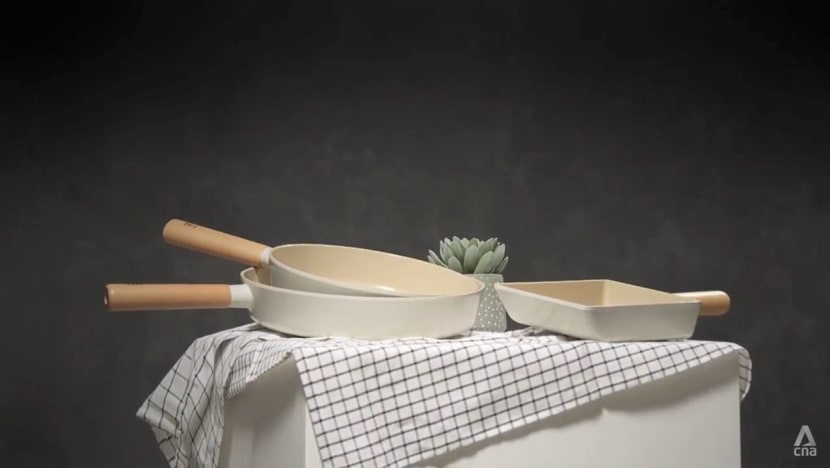Could non-stick pans become toxic? Here’s what you should know to stay safe
They make cooking convenient, but what are the potential health risks? The programme Talking Point speaks to experts, including one involved in a study in Singapore that could make people sit up and take notice.
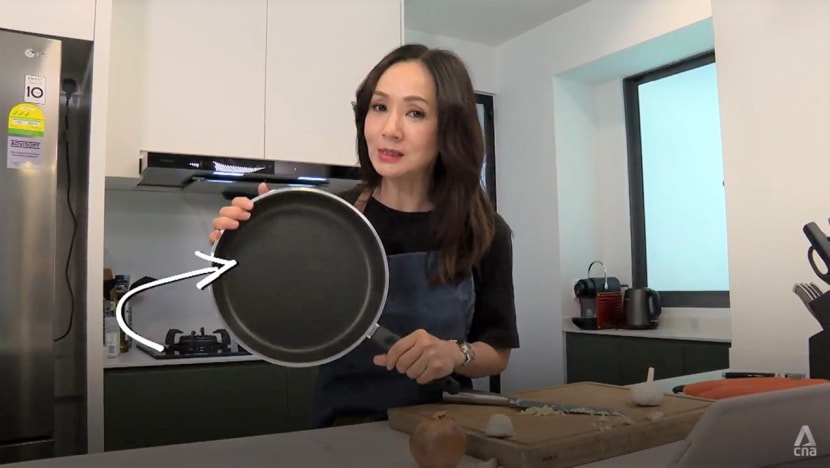
Several viewers of Talking Point wanted to know more about non-stick pans.
SINGAPORE: For as long as non-stick frying pans have been a mainstay in many home kitchens, there has been a debate about how safe these pans are.
Man-made chemicals are needed to make the pans’ non-stick coating: Widely known as “forever chemicals”, they are not easily broken down in the human body and take a long time to break down, if at all, in the environment too.
And now a study of more than 1,000 Singaporean women — which followed them as they attempted to get pregnant and through their pregnancy — has found that these chemicals can reduce fertility.
Women with a higher level of the chemicals in their bloodstream were 40 per cent less likely to fall pregnant within a year and 34 per cent less likely to have a live birth within the year.
The researchers considered a higher level of chemicals to be two to three nanograms per millilitre of blood. A nanogram is a billionth of a gram, not visible to the naked eye.
“That’s not a very high level,” said clinician scientist Jerry Chan at KK Women’s and Children’s Hospital, one of the researchers.
“It’s just about a tenth of that compared to, let’s say, the United States, Norway or even China, and yet we’re able to determine a negative impact on fertility.”
His advice to women who are trying to get pregnant or are pregnant is to “try to avoid potentially dangerous chemicals”.

“One of the ways to reduce the risk could be the avoidance of … non-stick cookware or even non-stick wrappers for your food,” he said.
But is this the only group who should worry about non-stick pans? The programme Talking Point finds out what makes these pans work their cooking magic and what precautions everyone can take.
WHAT IS IN A TEFLON PAN?
One particular type of non-stick pan dominates the market - those coated with polytetrafluoroethylene (PTFE), better known by its trade name, Teflon. As with all products, however, other chemicals are added during the manufacturing process.
In the noughties, one of these chemicals, perfluorooctanoic acid (PFOA), was linked to cancer and other health issues. By 2015, most major manufacturers had phased it out. And these days, non-stick pans are likely to come with PFOA-free labels.
WATCH: Non-stick pans — could they be toxic to you? (22:58)
But it has been replaced by GenX, which belongs to the same family of chemicals and performs the same job as PFOA: To prevent the non-stick coating from clumping together in clusters and give the pan its smooth surface.
Unpacking the science of non-stick pans, Tong Yen Wah, a National University of Singapore (NUS) associate professor of chemical and biomolecular engineering, said that because GenX and PFOA have a similar chemical structure, “theoretically, they’d have the same health effects”.
Non-stick cookware chemicals pose a risk if they seep into the food, which he said happens at around 250 degrees Celsius.
“In normal cooking, that won’t happen because we normally cook between 150 to 200 degrees. But it could happen (in) very small amounts,” he said.
The higher the temperature, the more chemicals will leach out … and go into our body after we eat (the food).”
It also matters if a Teflon pan has scratches. “Once you have a big, deep scratch, what happens is you create all these grooves,” he said.
“Then you have more contact with these ‘forever chemicals’ — so more contact points mean more of the (chemical) release can happen.”

Manufacturers have sought to reassure consumers, quoting studies that say PTFE has no health effects even when ingested. But they have also advised against overheating food when cooking, to avoid damaging the pans.
THE RISK SPECTRUM
Non-stick cookware, however, only scratches the surface of the problem. In recent years, cosmetics including foundation, fast food wrappers and even baby bibs have tested positive for these chemicals called per- and polyfluoroalkyl substances (PFAS).
Products that can resist water and grease would likely contain PFAS. And consumers love these products for their non-stick, stain-resistant and waterproof abilities.
The process of making these products, however, causes these chemicals to leak into the environment. They are emitted from factories into the air, go into land and sea when it rains and find their way into food and water supplies.
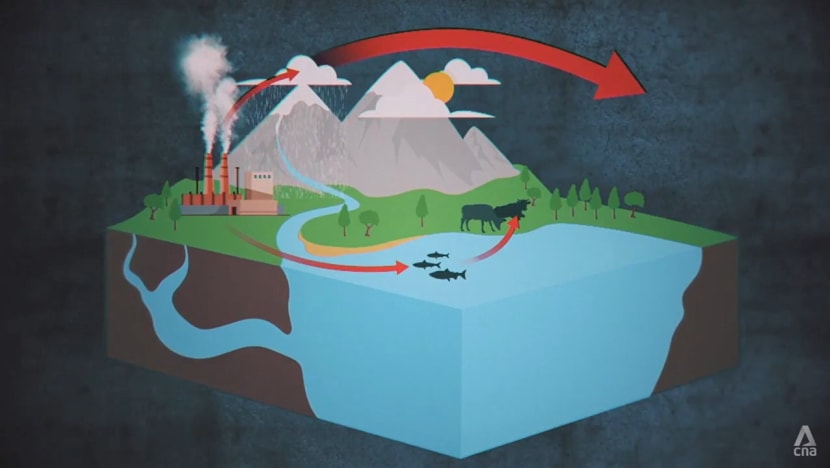
Researchers have found them even in remote areas: in rainwater on the Tibetan Plateau and, as reported last year, in the snows of Antarctica.
Increasingly, these chemicals are linked to a host of health problems such as liver damage and thyroid disease.
“In some countries, the ‘forever chemicals’ can be found in drinking water,” said pharmaceutical scientist Eric Chan from NUS’ department of pharmacy. “I’d regard this as the highest risk.”
In Singapore, which has included PFAS in the PUB’s routine testing and monitoring regime since 2016, “these compounds have not been detected in our drinking water”, the Ministry of Sustainability and the Environment said last year in a parliamentary reply.
Still, there are other sources of exposure: Chemicals may leak from grease-proof food packaging, some sunscreens contain PFAS — which can enter through the skin and circulate via the bloodstream — while the risk of leakage from wearables like raincoats is lower.
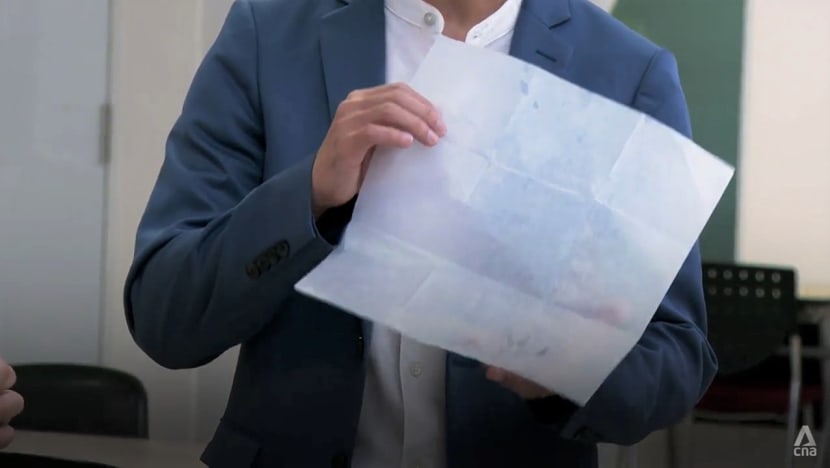
Non-stick frying pans are in the middle of the risk spectrum, according to Eric Chan, who echoed his NUS colleague’s views as he advised consumers to “really consider purchasing a new one” once their pan’s surface is scratched or corroded.
“What we’re concerned (about) is the chronic exposure. When the exposure is low, … yet the chemicals stay in our body for such a long time, the chemicals now get accumulated gradually,” he said.
“When they reach a minimum toxic level, they can cause damage to organs. In some cases, they can lead to even cancer.”
Researchers are still trying to figure out the impact of day-to-day, low-level exposure to these chemicals. “It’s an endemic problem, and it’s not going to go away soon,” said Jerry Chan.
“It’ll probably take the next few decades for us to understand the impact fully, as we’re now really studying the impacts on the children, on their puberty, their hormonal changes as they grow older.”

ALTERNATIVES TO TEFLON PANS
To reduce exposure, it is easiest for consumers to focus on two categories: Grease-proof food packaging and non-stick cookware.
When it comes to frying pans, one option is stainless steel. It is durable, resistant to damage and relatively easy to maintain. But can food fried on these pans slide off nicely?
Anthony Yeoh, chef-owner of French bistro Summer Hill, has some tips on cooking better with stainless steel.
First, preheat the pan on medium heat. “This is something that a lot of cooks make a mistake, at home, of (not) doing. And then … everything kind of gets mashed up and stuck to the pan,” he said.
“When the stainless steel is properly heated up, the metal expands, and it closes up all the little gaps — because the metal is actually porous.”
The way to test the pan’s temperature is to add drops of water. Normally, when the pan is not hot enough, the water will “stay in one spot and bubble like a little puddle”, instead of skating across the pan.

For another layer of non-stick properties, add oil to the pan, Yeoh advised.
One of the benefits of stainless steel is the food caramelises in minutes, “and that’s where all your flavour’s going to come from”, he said, whereas with non-stick pans, “it’ll take a long, long time to get that nice brown”.
Stainless steel is “easy to clean”, he added. “Unlike a non-stick pan, which they tell you, ‘Don't damage, don’t scratch, always use rubber tools’, you can just use a stainless steel sponge … go at it and scrub it all out.”
In a heavy-usage environment, he would use non-stick pans for “something like scrambled eggs”, otherwise the pans would not last long, while stainless steel pans are a “great all-rounder”.
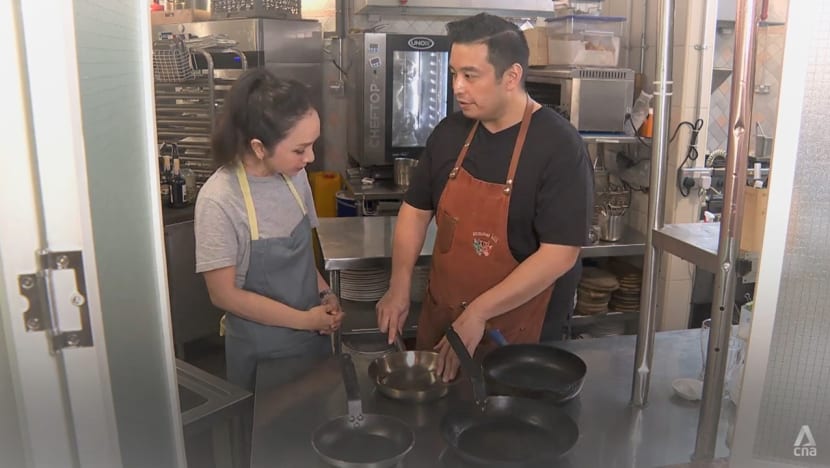
The “workhorse of the professional kitchen” is the carbon steel pan, which is a bit heavier and great for cooking steaks, for example.
“But unlike a stainless steel pan, you can’t really cook anything too acidic in this,” said Yeoh. “If you’re cooking a tomato sauce, this will give it … a metallic taste.”
Cast iron pans, meanwhile, are the ones “everybody kind of loves because they look pretty” and are “very traditional”. But “these are the ones that probably, out of all four, require the most maintenance”, he said.
These pans must be seasoned — rubbed with salt, oiled and put in a preheated oven — to develop a non-stick coating. “Then make sure you don’t damage the non-stick coating,” he added.
Then there is ceramic-coated non-stick cookware, which is made of silica, or essentially sand, and other inorganic materials.
They are perceived to be a safer non-stick cookware choice but do not last long — a year on average or “maybe three years or so” for the good ones, Yeoh reckoned — compared to common non-stick pans.
Watch this episode of Talking Point here. The programme airs on Channel 5 every Thursday at 9.30pm.
Read this story in Bahasa Indonesia here.
